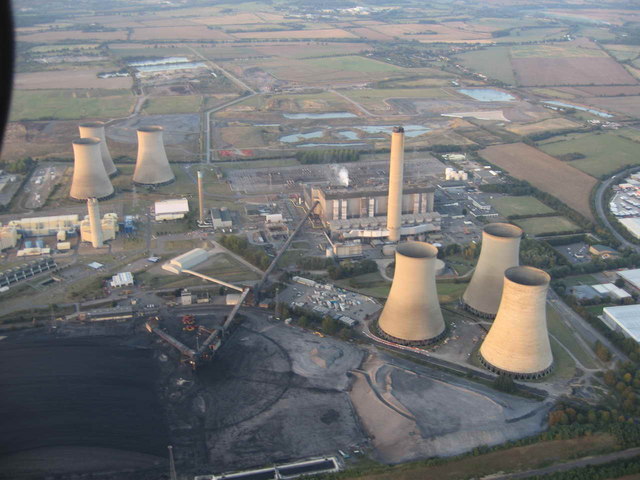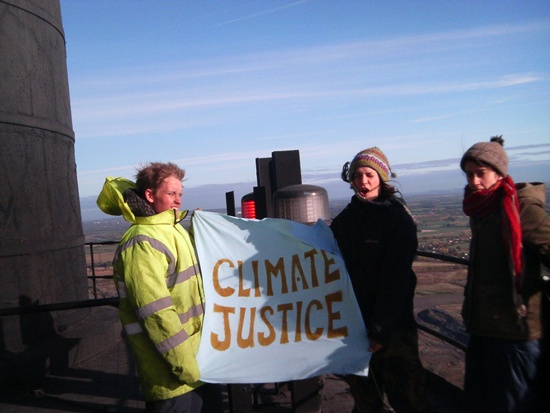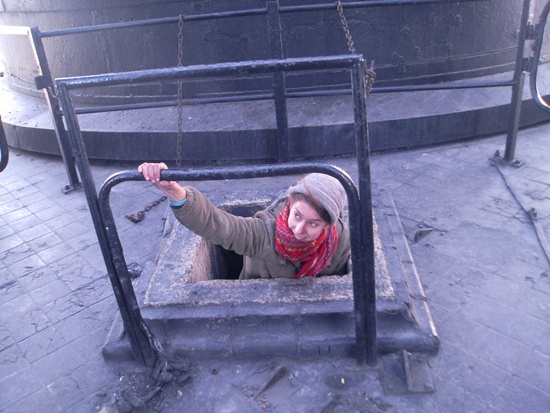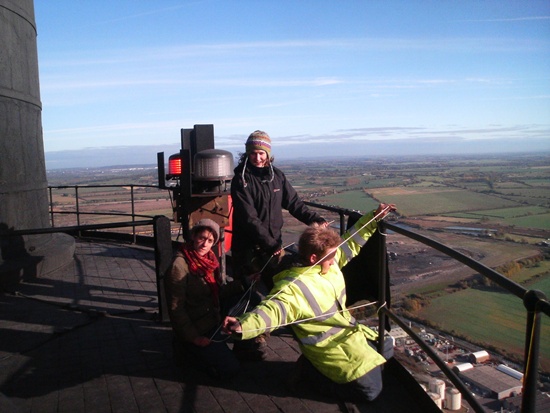The twenty peaceful protesters rode their push-bikes past security guards at 4.30am this morning before splitting into two groups. One team has shut down the giant coal conveyors which feed the boilers at the plant, while a second group of nine men and women has climbed the inside of the iconic 200m-high chimney and reached the top. They say they have enough food and water to stay in place for ‘weeks, not days’ - during which time the plant will be unable to operate. Already the activists in the chimney are securing the route behind them to ensure they can’t be reached by police and security guards.

Didcot Power Station
The huge coal plant in Oxfordshire is owned and operated by German utility company N-Power, which is building new coal plants across Europe and wants to build the first new coal-fired power stations in Britain in 30 years.
A small amount of coal was in the boilers as the invasion occurred. That will last for several hours, after which the protesters will scale the flues at the very top of the chimney (which would normally emit 1000 tonnes of CO2 an hour) and abseil into them, with some of the activists then living inside the chimney for the duration of their occupation. Activists will remain in the flues until their food and water runs out, preventing the station from re-opening.
“We’re a bunch of ordinary people who met at the Climate Camp this summer and were inspired to actually do something about climate change,” said Amy Johnson, 20, one of the protesters at the summit of the huge 200m chimney. “We rode our bikes into the power station this morning and now we’re on the top of the chimney. To be honest we’re quite surprised at how easy it all was. I didn’t quite expect to be here.”
She continued:
“Since E-ON shelved their plans to build a new coal plant at Kingsnorth this month, we realised N-Power is the new frontline. They haven’t dropped their plans to build the dirtiest new power stations in Britain for thirty years, and they’re constructing new coal plants right across Europe. We’re going to stay here until they say they’ll stop building new coal plants. We know that might take a while but we’re patient and we’ve got plenty of supplies to stay up here. We’re talking weeks, not days.”
Amy Johnson added:
“We decided the most powerful place we could set up a Climate Camp would be at the top of N-Power’s most iconic chimney, and that’s what we’ve done. I’d be a liar if said I wasn’t scared climbing up this smokestack, but climate change scares me a lot more. We’ve got people locked on to the coal conveyors and people are going over the top and inside the actual chimney. There’s no way we can be reached, we’re in control of this power plant and we’re not moving any time soon.”
The protesters researched today’s action carefully, putting the safety of N-Power staff and the activists first. The climbers preparing to abseil into the chimney are fully trained and highly experienced. The activists only shut down Didcot after confirming that their actions would not cause power cuts – there is always slack in the National Grid to cope with generating outages, forced or otherwise. If there is a displacement of emissions from coal to gas (or no generation) it will reduce net CO2 emissions in the course of the occupation by tens of thousands of tonnes.
Amy Johnson said:
“In every country CO2 emissions are linked to economic growth, so in countries like the UK our insatiable hunger for more and more products and consumer goods is driving climate change. The world’s finite resources need to be shared more fairly, and the richest countries which got us into this mess need to take the lead in reducing emissions. We’re on this chimney to demand climate justice as the world prepares to meet in Copenhagen. We’re defending human life and people’s property around the world that’s in immediate need of protection from the ravages of rising temperatures.”
While N-Power claims that new coal is necessary to ‘keep the lights on’, in reality its push for new coal plants at Tilbury and Hunterston is motivated by profit, with coal-burning being cheaper than other fuels despite its enormous climate impact. Consultants at Poyry - Europe’s leading independent energy experts - found that Britain could easily meet its energy demands without resorting to new coal as long as the country hits its renewable and energy efficiency targets.
Why coal, why Didcot?
* The single greatest threat to the climate comes from burning coal. Coal-fired generation is historically responsible for most of the fossil-fuel CO2 in the air today, about half of all fossil-fuel carbon dioxide emissions globally.
* Coal-fired power generation is the most environmentally damaging means of generating electricity yet devised. In fact, in carbon terms, coal is the dirtiest fuel known to man.
* Ed Miliband recently announced plans to allow the construction of four new coal plants that would emit about 80% of their emissions into the atmosphere. That would make them the most carbon-polluting new coal plants built in Britain for 30 years. N-Power is behind 2 possible plants, at Tilbury and Hunterston
* As we close old coal-fired and nuclear power stations in the next decade we will lose capacity currently providing around a quarter of our electricity output. But Gordon Brown recently committed to targets which will require us to generate about 35-40% of our electricity from renewables alone by 2020, and the UK also has fairly ambitious energy efficiency targets. According to Europe’s leading independent energy experts, Poyry, if the UK was to hit these existing renewables and efficiency targets, there will be no ‘energy gap.’ We can keep the lights on and cut emissions, and in the long run bring down fuel bills too – all without new coal-fired plants like Kingsnorth.
* The world’s most respected climate scientist, Dr. Jim Hansen, director of the NASA Goddard Institute for Space Studies, is so concerned about plans for new coal plants in Britain that he took the unprecedented step of writing to the Prime Minister to say that with the decision over whether or not to allow Kingsnorth, Brown has the potential to influence “the future of the planet”
* Coal-fired power generation really is an outdated technology for a 21st century, climate changing world. Even today, Britain’s centralised, inefficient coal-fired power stations waste over two-thirds of the energy they generate. The proposed new coal plant at Kingsnorth, although more efficient than the old one, would still use old-style conventional technology that would waste (as heat) over half of all the energy the power station creates. Compare that with the state-of-the-art power plants they use in Scandinavia which run at up to 94% efficiency.
* Burning coal in the UK has already halted the decline in emissions seen in the 1990s following the ‘dash for gas’ and has undermined progress from other sectors in cutting emissions. Since Labour came to power, carbon dioxide emissions have actually increased and this can be attributed in large part due to ‘the roll to coal’ as well as increased aviation emissions.
* Dr. Jim Hansen, one of the first climate scientists to warn of global warming, says: “The only practical way to prevent CO2 levels from going far into the dangerous range, with disastrous effects for humanity and other inhabitants of the planet, is to phase out use of coal except at power plants where the CO2 is captured and sequestered.”
* Equally, Sir Martin Rees, President of the prestigious Royal Society, wrote to the Government saying, "Allowing any new coal-fired power station, such as Kingsnorth, to go ahead without a clear strategy and incentives for the development and deployment of carbon capture and storage (CCS) technology would send the wrong message about the UK's commitment to address climate change, both globally and to the energy sector.”
"I therefore suggest that the government only gives consent to any new coal- fired power station, such as Kingsnorth, on condition that the operating permits are withdrawn if the plant fails to capture 90% of its carbon dioxide emissions by 2020. This would send a clear policy signal to industry of the need to develop and deploy CCS as quickly as possible."
* Lord Adair Turner’s inaugural report from the Committee on Climate Change sets out that achieving an 80% domestic reduction in emissions by 2050 means the decarbonisation of the UK power sector must start now and continue through the 2020s, so that we can secure the “almost total decarbonisation of electricity generation by 2030”.





Comments
Display the following 21 comments